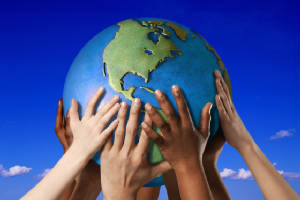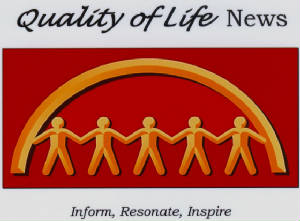The "Evolutionary
Wall"
Notable author Duane Elgin eloquently
discusses this important topic:
“An evolutionary wall refers not only to the physical limits of the Earth’s
ability to sustain humanity, but also to our own social and spiritual limits to sustain dysfunctional
and destructive behaviors. Modern, industrial civilization is breeding pathological behavior—alienation
from others and from nature, extreme competitiveness and greed, cynicism in politics, and despair for the future.
How much poverty, alienation, and misery can humanity experience before we eventually damage our collective psyche
and soul?…Do we see ourselves as separate, isolated beings or part of the larger web of life?” (1)
The Larger Web of Life
There is a larger web of life, to be sure, and writer Elizabeth
Gilbert addresses the rippling benefits of resolving strife between individuals:
“…The health
of the planet is affected by the health of every individual on it…If even one or two souls can be free from
discord, this will increase the general health of the whole world, the way a few healthy cells in a body can increase the
general health of that body…[If] two more people can have the chance to be free and healthy,…there will be just
a little less animosity and bitterness in a world that is already far too troubled by suffering.” (2)

(1) Duane Elgin,
The Promise Ahead, New York: HarperCollins Publishers, 2000, pages 10-11.
(2) Elizabeth Gilbert, Eat, Pray, Love, New York: Penguin Books, 2006, pages
32-33.
"Think like an ecosystem, and you just might
save the world."
So asserts Frances Moore Lappé, the founder of the Small Planet Institute. She believes that there are six
inherent traits we can foster that will help us manifest the essential truth that "we live in relation to everything
else" and, by so doing, avoid global catastrophe:
* Cooperation
* Empathy
* Fairness
* Efficacy
* Meaning
* Imagination/creativity/attraction to change
Empowered by these, we can reverse three dangerous trends:
Extreme power inequalities,
secrecy, & scapegoating
----> paradigm shift ---->
Dispersed power, enhanced transparency, & mutual accountability
She also addresses the destructively widespread "presumption
of lack" rather than a more expansive concept of abundance and inclusion.
Read Lappé's compelling article, and free your "Eco-Mind."
Interested in our monthly News Clipping Service Subscription? Comes via email and works out to only 25¢ per week.
 |
 |
DID YOU KNOW?
* "It is not the strongest of the species that survive, nor the most
intelligent, but the one most responsive to change." — Charles Darwin
* Terrific resource for finding where to recycle various hazardous materials
by zip code.
 * California
has restricted energy-guzzling TV sets. There could be a reduction
in greenhouse gas emissions of 3 million metric tons per year, and consumers may save $8.1 billion in energy costs over
a 10-year period.
* Potent
new rat poisons used in the U.S. are getting into the food chain (hawks, owls, coyotes, etc.) and causing massive internal
bleeding, turning the insides of these animals into "soup."
* Learn about green eating in a guide to pesticides in produce.
The Human Family & The Environment We are all painfully aware that prevalent current shortsighted approaches are condemning our environment.
The U.S. in particular often suffers from tendencies towards feelings of entitlement and grandiosity regarding its
own position as a global citizen. Those tendencies in part have contributed to the condition in which we
find our planet today:
“The
average American generates about 15,000 pounds of carbon dioxide every year from personal transportation, home energy use
and from the energy used to produce all of the products and services we consume.” (3A)
Fortunately though, there are many actions we can take, both individually and as a nation,
to mitigate or reverse the problem. Here is just a sampling of steps you can make to reduce our impact
at home:
“Most emissions from homes are from the fossil fuels burned
to generate electricity and heat. By using energy more efficiently at home, you can reduce your emissions and lower your energy
bills by more than 30%.In addition, since agriculture is responsible for about a fifth of the world’s greenhouse gas
emissions, you can reduce your emissions simply by watching what you eat. [Some
other very simple actions that we can take will have a significantly positive cumulative impact:]
* Replace a regular incandescent light bulb with a compact fluorescent light bulb (cfl):
CFLs
use 60% less energy than a regular bulb. This simple switch will save about 300 pounds of carbon dioxide a year. If every
family in the U.S. made the switch, we’d reduce carbon dioxide by more than 90 billion pounds!
* Move your thermostat down 2° in winter and up 2° in summer:
Almost half
of the energy we use in our homes goes to heating and cooling. You could save about 2,000 pounds of carbon dioxide a year
with this simple adjustment.
* Clean or replace filters on your furnace
and air conditioner:
Cleaning a dirty air filter can save 350 pounds of carbon dioxide a year.
* Install a programmable thermostat:
Programmable thermostats will automatically
lower the heat or air conditioning at night and raise them again in the morning. They can save you $100
a year on your energy bill.
* Choose energy efficient appliances
when making new purchases:
Look for the Energy Star label on new appliances to choose the most efficient models. If each household in the U.S. replaced
its existing appliances with the most efficient models available, we’d eliminate 175 million tons of carbon dioxide
emissions every year!
* Wrap your water heater in an
insulation blanket:
You’ll save 1,000 pounds of carbon dioxide
a year with this simple action. You can save another 550 pounds per year by setting the thermostat no higher than 120 degrees
Fahrenheit.
* Use less hot water:
It takes
a lot of energy to heat water. You can use less hot water by installing a low flow showerhead (350 pounds of carbon dioxide
saved per year) and washing your clothes in cold or warm water (500 pounds saved per year) instead of hot...
* Turn off electronic devices you're not using:
Simply
turning off your television, DVD player, stereo, and computer when you’re not using them will save you thousands of
pounds of carbon dioxide a year.
* Unplug electronics from the wall
when you’re not using them:
Even when turned off,
things like hairdryers, cell phone chargers and televisions use energy. In fact, the energy used to keep display clocks lit
and memory chips working accounts for 5 percent of total domestic energy consumption and spews 18 million tons of carbon into
the atmosphere every year!
* Only run your dishwasher when there’s
a full load and use the energy-saving setting:
You can
save 100 pounds of carbon dioxide per year.
* Insulate and
weatherize your home:
Properly insulating your walls and ceilings can save 25% of
your home heating bill and 2,000 pounds of carbon dioxide a year. Caulking and weather-stripping can save another 1,700 pounds
per year. Be sure you’re recycling at home:
You
can save 2,400 pounds of carbon dioxide a year by recycling half of the waste your household generates. Earth 911 can help you find recycling resources in your area.
*
Buy recycled paper products:
It takes 70 - 90% less energy to make recycled paper and it prevents the loss of forests worldwide.
* Plant a tree:
A single tree will absorb one ton of carbon dioxide over its lifetime. Shade provided by trees can also reduce
your air conditioning bill by 10 to 15%.” (3B)
It
is a challenge to transform our way of thinking and living, but one that is essential for our overall survival.
We can personally and globally address these ideas in tandem if we are truly committed to do so.
How
many of the aforementioned conservation strategies do you think you can take action on today?
Plus for how
kids can reduce, reuse, and recycle waste, be sure to check out this page. In
addition, here is information regarding electronics and appliances recycling at Best Buy, as well as great tips on reducing, reusing, and recycling plastic.
(3A & 3B) From the original website for the movie An Inconvenient
Truth.
 |
